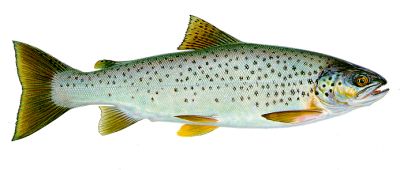
The Loch Leven Trout

|
Loch Leven Brown Trout The brown trout of Loch Leven
is considered by many anglers to be the 'perfect' trout, both
for its graceful form and its sporting qualities. |
Following the retreat of the ice sheets from northern Britain some10,000 years ago, a massive block of ice was left stranded just north of the Firth of Forth in what is now southeast Scotland. As the climate slowly warmed, the ice melted, and its water cut a river into the Forth at Largo Bay. The lake that now fills the depression made by this gigantic block of ice has become the most famous trout water in the world: Loch Leven.
Since the middle of the 19th century, the Loch Leven strain of brown trout has been transported to many regions that were formerly far beyond the range of any trout species: Argentina, the Indian subcontinent, the Falkland Islands, Australia and New Zealand. In North America it now lives alongside the native rainbow and cutthroat trout. And in fisheries throughout Europe, trout farmers take pride in the knowledge that their brown trout originate from the Loch Leven strain.
Presumably Loch Leven was colonised soon after the ice melted, by trout from the sea running through the Forth and the River Leven. Over thousands of years the trout population became specially adapted to life in the loch. They acquired a coloration that presumably camouflages them from predators better than any other. They became adapted to feeding on the invertebrates with which the loch abounds, especially crustaceans such as the freshwater shrimp and planktonic Daphnia, which are rich in carotenolds and produce the appetising redness of the trout flesh.
A freshly-caught Loch Leven trout can quite easily be distinguished from trout caught elsewhere. Early scientists considered it a separate species. Before Dr Günter and the Reverend Houghton referred to the Loch Leven trout as Salmo levenensis, a Dr Parnell named it Salmo caecifer because of the large number of 'caecae' or appendices that it had in its gut system.
However, when stocks of Loch Leven trout are taken and introduced into other waters they lose some of the characteristics that they have in their natal loch. They interbreed freely with any other brown trout in the water, and very quickly become almost indistinguishable from the trout native in the lake or river. Even in fish farms where the strain is kept isolated from others, some of the Loch Leven characteristics can soon be lost; especially the colour. So to see a Loch Leven trout at its best there is no choice: you have to go to Loch Leven.
The quantities of trout caught on rod and line, all on fly, from Loch Leven are quite immense for the size of the water. Less than 20,000 in the season is a bad season, 30,000 a reasonable one, 40,000 a very good season. In 1929 it is recorded that 53,605 trout were taken at an average of 15 trout per acre. Considering that the average weight is close to the pound mark, it is clear that the loch is a very productive fishery.
The loch does not, however, produce big trout in quantity and anything over the 5 lbs. mark must be considered exceptional. As recently as 1980 one of 6 lbs. 3 Oz was taken by W. Hatten on a McLeod's Olive Fly; and in 1983, Eugene Grube had one of 5 lbs. 12 oz. But pride of place must go to Colonel Scott's fish of 9 lbs. 13 oz, caught on 8 September 1911: to this day it still resides in a glass case in the Fishery Centre at Kinross Pier.
In former centuries, Loch Leven was about four miles long and three miles wide. But in December 1830 a drainage scheme was completed that dropped the water level of the loch by up to nine feet and reduced its area by almost a quarter. The scheme also involved cutting a new channel for the outflowing River Leven and creating sluices to control the flow of water from the loch.
The appearance of the loch before the drainage can be gauged by the visitor at the old churchyard of Kinross. Originally the water lapped at the foot of the churchyard wall. On Castle Island, when Mary, Queen of Scots, was imprisoned there in the 1560s, the loch reached the battlements. Today the loch reveals seven islands, but prior to the drainage there were but four: St Serf’s, Castle, the Reed Bower and Roy's Folly. Most of the loch is now very shallow, with the exceptions of two 6o-foot holes to the cast of Scart Island and around the western and southern sides of St Serfs. Before 1830 the large area known as "The Shallows" was more than twice its present depth.
This massive alteration has had major effects on the fish populations of Loch Leven. Salmon, and possibly sea trout, ran the old River Leven: they are gone. So too is the char which, presumably, could not tolerate the shallower water. The pike is also extinct here, but not because of the drainage: it was exterminated to protect the trout stocks (in 1903 14,000 pike were removed by netting).